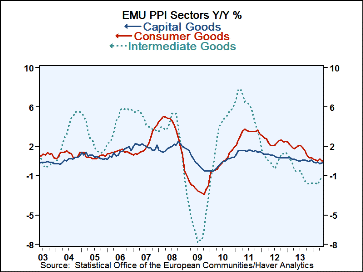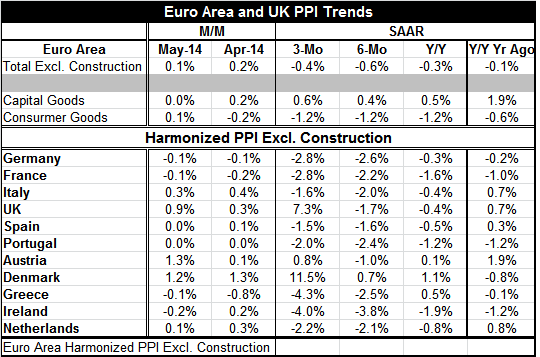 Global| Jul 02 2014
Global| Jul 02 2014EMU PPI Is Still Weak
Summary
PPI trends in the EMU continue to push lower. The chart shows that only intermediate goods inflation trend has a small upturn in recent months. In May the PPI (excluding construction) rose by 0.1% after a 0.2% April increase. Still, [...]
 PPI trends in the EMU continue to push lower. The chart shows that only intermediate goods inflation trend has a small upturn in recent months.
PPI trends in the EMU continue to push lower. The chart shows that only intermediate goods inflation trend has a small upturn in recent months.
In May the PPI (excluding construction) rose by 0.1% after a 0.2% April increase. Still, the three-month growth rate is negative at -0.4% (SAAR). Inside of one year the PPI shows inflation rather steady in a narrow range, hovering around -0.5%. But year-over-year trends still are heading lower.
Various EMU countries still show a good deal of PPI weakness. In May, four of eleven countries show PPI prices falling. In April, three of eleven show prices falling. Over three months, eight of eleven show dropping producer prices. Ten of eleven show dropping prices over six months. Over one year, eight of eleven show dropping prices.
These trends are broad although the price drop tendencies are lessening in the past two months. That is too short a time to make a dependable trend. And measures of activity in the EMU have weakened, giving us less reason to think that the environment should firm prices.
For now the European Central Bank's fight to stimulate credit expansion and growth in the EMU seems to be as necessary as ever. Consumer goods prices are still dropping sharply over all horizons, but capital goods prices are showing steady if moderate expansion. The consumer sector still appears to be the weak spot in Europe. Some consumer confidence measures have begun to stir. Unemployment has been steady at still elevated levels for the past two months. Unemployment will need to fall if solid improvements in consumer confidence are to be made.

Robert Brusca
AuthorMore in Author Profile »Robert A. Brusca is Chief Economist of Fact and Opinion Economics, a consulting firm he founded in Manhattan. He has been an economist on Wall Street for over 25 years. He has visited central banking and large institutional clients in over 30 countries in his career as an economist. Mr. Brusca was a Divisional Research Chief at the Federal Reserve Bank of NY (Chief of the International Financial markets Division), a Fed Watcher at Irving Trust and Chief Economist at Nikko Securities International. He is widely quoted and appears in various media. Mr. Brusca holds an MA and Ph.D. in economics from Michigan State University and a BA in Economics from the University of Michigan. His research pursues his strong interests in non aligned policy economics as well as international economics. FAO Economics’ research targets investors to assist them in making better investment decisions in stocks, bonds and in a variety of international assets. The company does not manage money and has no conflicts in giving economic advice.






